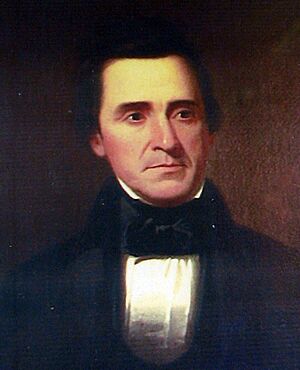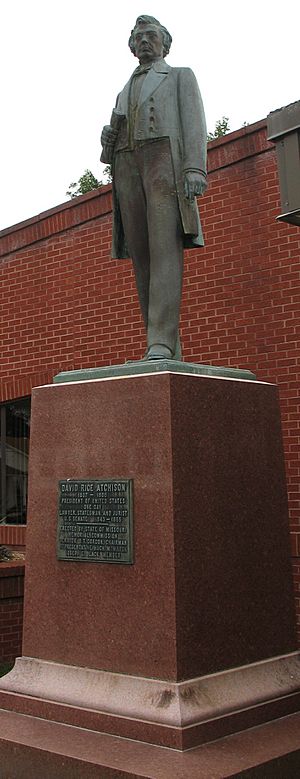David Rice Atchison facts for kids
Quick facts for kids
David Rice Atchison
|
|
|---|---|
 |
|
| President pro tempore of the United States Senate | |
| In office December 20, 1852 – December 4, 1854 |
|
| Preceded by | William R. King |
| Succeeded by | Lewis Cass |
| In office August 8, 1846 – December 2, 1849 |
|
| Preceded by | Ambrose Hundley Sevier (acting) |
| Succeeded by | William R. King |
| United States Senator from Missouri |
|
| In office October 14, 1843 – March 3, 1855 |
|
| Preceded by | Lewis F. Linn |
| Succeeded by | James S. Green |
| Member of the Missouri House of Representatives |
|
| In office 1834–1841 |
|
| Personal details | |
| Born | August 11, 1807 Lexington, Kentucky, U.S. |
| Died | January 26, 1886 (aged 78) Gower, Missouri, U.S. |
| Resting place | Greenlawn Cemetery, Plattsburg, Missouri, U.S. |
| Political party | Democratic |
| Alma mater | Transylvania University |
| Profession |
|
| Signature | |
| Military service | |
| Allegiance | |
| Branch/service | |
| Years of service | 1838 (MVM) 1861–1862 (MSG) |
| Rank | |
| Battles/wars | Missouri Mormon War |

David Rice Atchison (born August 11, 1807, died January 26, 1886) was an important politician from Missouri in the mid-1800s. He was a United States Senator and served as the President Pro Tempore of the Senate for six years. This role meant he was in charge of the Senate when the Vice President wasn't there.
Atchison is famous for a story that claims he was the Acting President of the United States for one day. This was supposedly on Sunday, March 4, 1849. However, most historians don't believe this claim.
Atchison owned a large farm where enslaved African Americans were forced to work. He was a strong supporter of slavery. He was also a leader in the "Bleeding Kansas" events. These were violent conflicts before Kansas became a state.
Contents
Early Life and Education
David Rice Atchison was born in Frogtown, Kentucky, which is now part of Lexington, Kentucky. He went to Transylvania University in Lexington. Many of his classmates later became important politicians. Atchison studied law and became a lawyer in 1829.
Becoming a Lawyer and Politician in Missouri
In 1830, Atchison moved to Liberty, Missouri, and started his law practice. He also owned a farm where he used enslaved labor. One of his most well-known clients was Joseph Smith, Jr., who founded the Latter Day Saint movement. Atchison helped Smith with land problems.
In 1834, Atchison was elected to the Missouri House of Representatives. He worked to expand Missouri's border to the Missouri River. This land was called the Platte Purchase.
When conflicts broke out in 1838, known as the 1838 Mormon War, Atchison became a major general in the state militia. He helped to stop the fighting. He was re-elected to the Missouri State House in 1838. Later, he became a judge and a county commissioner.
Time in the U.S. Senate
In 1843, Atchison was chosen to fill a vacant seat in the United States Senate. He was the first senator from western Missouri. At 36, he was also the youngest senator from Missouri at that time. He was re-elected for a full term in 1849.
Atchison was very popular with other Democratic senators. In 1845, they chose him as President pro tempore. This made him second in line to become president, after the Vice President. He held this position for several years.
As a senator, Atchison strongly supported slavery and expanding the United States. He supported adding Texas to the U.S. and the Mexican–American War. Atchison and Thomas Hart Benton, Missouri's other senator, became rivals. Benton was against slavery, and Atchison worked with other parties to prevent Benton's re-election.
Atchison wanted to open the land west of Missouri (now Kansas and Nebraska) for settlement. He suggested that settlers in these new territories should vote to decide if slavery would be allowed there. This idea was called "popular sovereignty."
Senator Stephen Douglas introduced this plan as the Kansas–Nebraska Act in 1853. The Act passed in 1854, creating the Kansas and Nebraska Territories.
The Border Ruffians
Atchison believed that Kansas would become a slave state. In 1854, he helped start the town of Atchison, Kansas, as a pro-slavery settlement.
However, many people who were against slavery moved to Kansas. This made Atchison and his supporters angry. Atchison gathered a large group of armed Missourians, known as the "Border Ruffians."
On election day in March 1855, Atchison led about 5,000 Border Ruffians into Kansas. They took control of voting places and cast many fake votes. This resulted in a pro-slavery legislature being elected. Even though the governor objected, he was fired by President Franklin Pierce.
Despite these efforts, more people against slavery moved to Kansas. There was ongoing violence between both sides during this time, known as "Bleeding Kansas." In the end, Kansas became a free state in 1861.
Charles Sumner, another senator, gave a famous speech in 1856. He described the violence and actions of Atchison and his men in Kansas.
Leaving the Senate
Atchison's Senate term ended in 1855. He tried to be re-elected, but the Missouri legislature couldn't agree on a candidate. No senator was chosen until 1857.
Atchison also wanted the first transcontinental railroad to go through Missouri and Kansas. He suggested a route that would pass through the town named after him.
During the American Civil War
When the American Civil War began, Atchison supported Missouri joining the Confederacy. He became a major general in the Missouri State Guard. He helped recruit soldiers and fought in battles. In September 1861, Atchison led troops to victory against Union forces in the Battle of Liberty.
Atchison served until early 1862. After Union forces won a major battle in Arkansas, Atchison resigned and moved to Texas. He returned to his farm in Missouri after the war. His home and all his important papers were lost in a fire before he died.
The "One-Day Presidency" Claim
Inauguration Day in 1849 fell on a Sunday, March 4. Because of this, President-elect Zachary Taylor did not take his oath of office until Monday, March 5. The term of the old president, James K. Polk, ended at noon on March 4.
At this time, Atchison was the President pro tempore of the United States Senate. According to the rules then, the President pro tempore was next in line for the presidency if the President and Vice President were unable to serve. Since neither the new President nor Vice President had been sworn in on March 4, some of Atchison's friends claimed he was the acting president for 24 hours.
However, most historians and experts disagree with this claim. They point out that Atchison's Senate term also ended on March 4. Also, a president doesn't need to take the oath to officially become president. Even if an oath was needed, Atchison never took one. So, he was not considered president.
Death and Legacy
David Rice Atchison died on January 26, 1886, at his home in Missouri. He was 78 years old. He is buried in Greenlawn Cemetery in Plattsburg, Missouri. His tombstone famously reads, "President of the United States for One Day."
- The city of Atchison, Kansas, and Atchison County, Missouri, are named after him.
- A ship, the USS Atchison County (LST-60), was also named in his honor.
- In 1991, Atchison was recognized in the Hall of Famous Missourians. A statue of him is in the Missouri State Capitol.
- The Atchison County Historical Museum has a small exhibit about him, jokingly called the "World's Smallest Presidential Library."
See also
- List of American Civil War generals (Confederate)
- List of United States senators from Missouri



